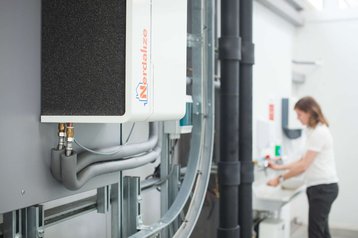Computers generate heat when they are turned on. All the electric energy they receive eventually turns into heat: that’s the rules of thermodynamics. And if you pack your IT load in tightly to save space, you have to get rid of that heat, or the whole thing will melt.
That’s a problem. But heat is not a bad thing in itself. We all use heat. It’s been humanity’s friend for millennia longer than the artificial brains we build in racks. We warm ourselves, we cook food, and enjoy the comfort of hot baths and showers.
You can’t avoid producing heat
In the data center, heat is a by-product. It is inevitably produced and it has to be removed. The drive to make data centers more efficient is a movement to get more computing out of a given amount of input energy. This means reducing the amount of heat produced if possible, as well as the amount of energy used in getting rid of it.
Even at the highest levels of efficiency imaginable, there is still heat to be expelled. That’s a problem - but some people want to see that problem as an opportunity. Why not treat that heat as a useful output? Why not harness it? The trouble was, data centers aren’t generally built amongst mass housing. They aren’t near to potential users of heat: so the heat has to be transported,
Most data centers are cooled by air, and air isn’t great for transporting heat. By the time that hot air has been piped somewhere useful, it’s normally cooled down to a useless temperature. There are exceptions, such as the district heating systems available in some countries - for instance, Stockholm has one, which includes an H&M data center among its heat suppliers. But let’s leave those for another time, because there’s another, more radical idea for re-using the heat.
If you can’t take the heat from the data center to the homes and offices where it could be used, why not take the data center into those places?
From theory to reality
Microsoft coined the term “data furnace” in 2011, to describe a networked processor sitting in a home, providing heating and hot water while performing tasks sent to it by a service provider. A network of these systems could become a distributed data center. Its heat energy would be harnessed,
It’s taken a cohort of enthusiastic start ups to begin to put this into practice, Cloud & Heat in Germany puts a rack in the basement of apartment blocks. Qarnot in France puts a heater on the walls of Parisian flats - inside it a processor does financial and image processing work, and the heat gets used in the building.
Edge processing could reconnect data centers with people, feeding our primal need for warmth
In Amsterdam, Nerdalize has a deal with a power utility to install similar units. It’s just completed a successful pilot (see picture above). And back in France, Stimergy is heating a swimming pool while performing HPC calculations. These are small outfits, performing niche jobs. But so called “edge” resources, close to users and devices are necessary.
Edge facilities won’t replace centralized data centers, running efficiently on renewable power. Qarnot’s business model accepts that - the company has had investment from French data center operator Data4 which offers Qarnot processing alongside its own. But it’s a mighty promising field, and it could lead to data centers reconnecting with people, as part of that resource moves into our homes and feeds our primal need: for friendly warmth.
A version of this article appeared on Verne Global’s site



